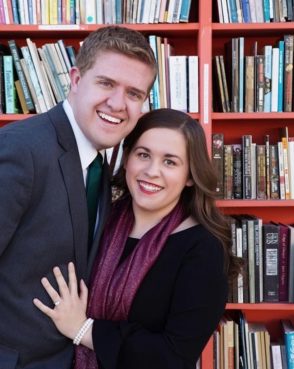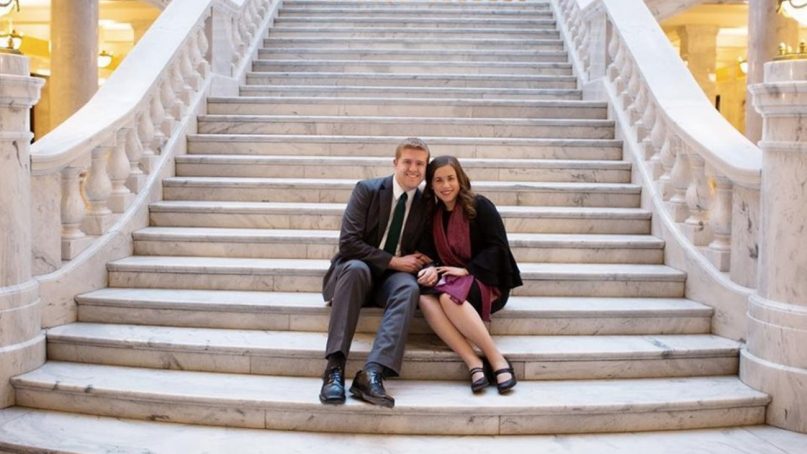SALT LAKE CITY — Kayla Bach is getting married in the Newport Beach, Calif., Latter-day Saint temple in little more than a week.
So when leaders of The Church of Jesus Christ of Latter-day Saints announced Monday (May 6) that the church was eliminating the yearlong waiting period between a civil marriage and a temple “sealing,” Bach thought it was an important, inclusive change for U.S. members in the global faith.
Initially, though, Bach — an undergraduate at Provo’s Brigham Young University — didn’t imagine it would apply to her.
Then her dad asked, “Why don’t you consider doing it?”
When Bach’s father joined the Utah-based faith several decades ago, none of his family could attend his temple wedding. It was painful and frustrating to him, creating feelings of family tension with his kin.
Adding a civil wedding meant that Bach’s non-LDS family members could attend.
So the bride-to-be thought, why not?
Bach discussed it with her fiance, Dayne Bloxham, a BYU graduate. And though his family could all be with them in the temple, he agreed.
They scrambled to add a civil wedding at a historic courthouse on the morning of May 17 before her afternoon temple wedding.

Kayla Bach and Dayne Bloxham are engaged to be married. Photo courtesy of Brandon Burk Photography
Relatives on her dad’s side stood outside the temple several decades ago and were willing to do it again for her, Bach said, “but including them in our wedding festivities will make it even more meaningful.”
Marrying in the “eyes of the law and the eyes of the church,” she said, will show that “we take both seriously.”
It’s too soon to know how many couples will follow Bach’s lead — though comments on social media indicate others are doing so — and the extent to which the policy change will impact Utah’s wedding industry.
Steve Williams, owner of the Eldredge Manor in Bountiful, predicts a clear shift in the Utah wedding landscape.
“It’s going to change our business somewhat dramatically,” he said, joking that “we are going to be setting up a lot more chairs.”
It will mean more physical work for Williams and his staff but not necessarily a lot of extra income. Still, he welcomes the change.
“So many families need this,” he said. “It will be really great for relations between LDS and non-LDS. It won’t be us versus them. It will bring people together.”
After 45 years in the wedding business, Williams has seen Latter-day Saint wedding traditions adapt to meet the times.
“Back in the ’70s, you really only saw LDS brides marry LDS grooms,” he said. “Today, it’s rare to see two fully involved LDS families marry each other. Either the bride’s side or the groom’s side is not part of the faith.”
It’s one reason, Williams noted, that in recent years “we have seen an increase in ring ceremonies” — not a formal wedding but an optional event where couples exchange rings and vows before all their invited loved ones outside temples.
If Latter-day Saint brides want to have a civil ceremony at a venue other than their local church meetinghouse — which would be free — they may have to learn to be more flexible on wedding dates.
“Brides from other faiths know they need to book at least six months to a year in advance,” he said. “Our (Latter-day Saint) culture does not have long engagements, so they’ve got be more flexible.”
Meagan Crafts Price, marketing director for Culinary Crafts Catering, believes Utah weddings will change gradually. “You won’t see it this summer, she said. “It will take five to 10 years” for a cultural shift to occur.
“You might even see a struggle,” she said, between young couples with more modern ideas and their more traditional Latter-day Saint parents.
Others, including Kathy Cushman, believe Utah’s traditional wedding scene will remain pretty much the same.
“I don’t see it changing drastically,” said the owner of Utah DIY Wedding, a party supply and rental shop in Payson. “Our whole culture in the church is to grow up and get married in the temple.”
In recent years, Cushman has seen more brides split the festivities into two separate days, having the reception one day and the temple ceremony another. She expects that to grow under the new civil-wedding policy.
“It puts more of an emphasis to the actual (temple) sealing,” she said, “and the couple is not trying to rush through the important part of the wedding.”
Latter-day Saints believe marriages can be tied, or sealed, for eternity.

Harrison Trinca and Abigail Roush are engaged to be married. Photo by Mason Trinca, courtesy of Abigail Roush
Abigail Roush had heard a rumor that a possible change in the sealing waiting period might be announced at the faith’s General Conference in April.
When it didn’t happen, Roush was resigned to having a “ring ceremony” in the morning as a way to include her fiance’s family in the June 14 wedding in Salt Lake City before heading to the temple that night.
Her fiance, Harrison Trinca, was a convert to the faith, and about 40 of his extended clan, who are not Latter-day Saints, were planning to come to the festivities.
On Monday, Roush was bombarded with texts from her sister and dozens of friends, detailing the church’s big announcement.
In a flash, the couple decided the ring ceremony would become the actual nuptials.
“I got really excited,” she said. “I called my fiance and his family. They were all really happy.”
Roush is glad, she said, that it is now an option for couples.
As for Bach, adding a legally binding exchange of vows at the courthouse before the temple ceremony was a hassle, but she felt it would be worth it.
She was an only child and so was close to her entire extended clan, including cousins, aunts and uncles on her dad’s side, who were not Latter-day Saints.
Even her future in-laws, though they had a deep Mormon heritage on both sides, were OK with the move.
“When my fiance’s mother was married, many of her relatives couldn’t come in the temple with her,” Bach said, so she could identify with Bach’s desire to be more inclusive.
Her fiance’s father saw it as “an excellent missionary opportunity,” she said, where outsiders could see how much Latter-day Saints value marriage and family.
Bach herself had seen the two-track approach (with no one-year delay between wedding and sealing) work in Chile, where she served a Latter-day Saint mission.
“I witnessed the people doing this — getting married civilly and then going to the temple,” she said. “I saw how it worked for them. Some made a big deal about it; others just did it.”
Bach is excited to see how this will play out in the church.
But she is especially happy to see its impact on her dad — who is feeling blessed to share this joy with his family.
(Peggy Fletcher Stack and Kathy Stephenson write for The Salt Lake Tribune. This story has been updated.)





